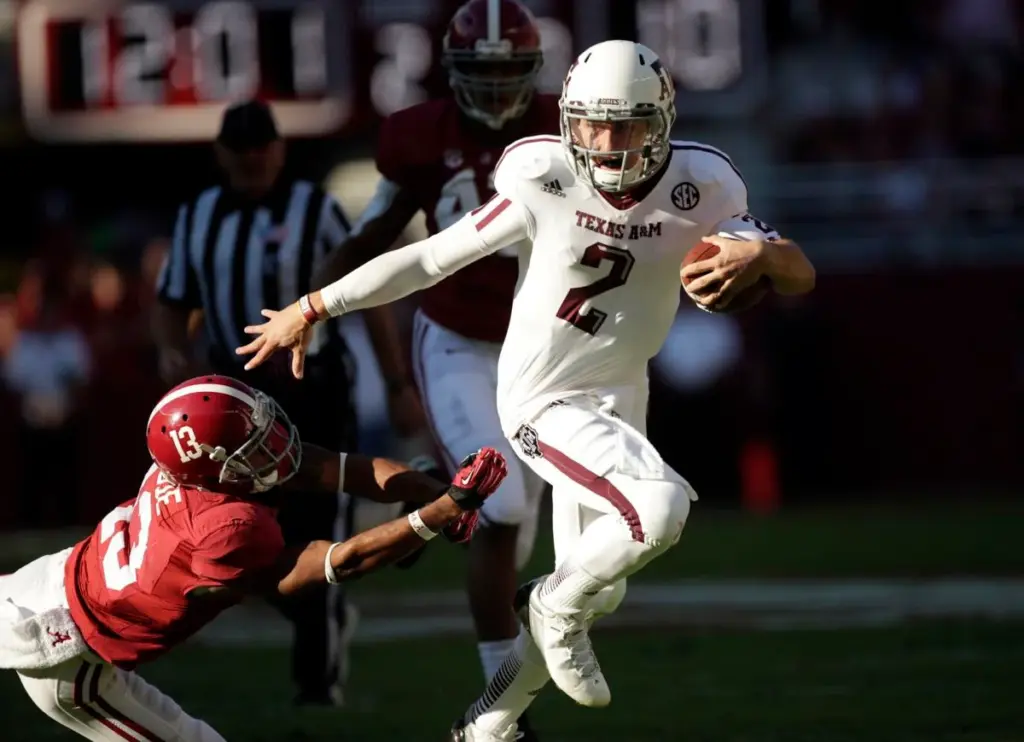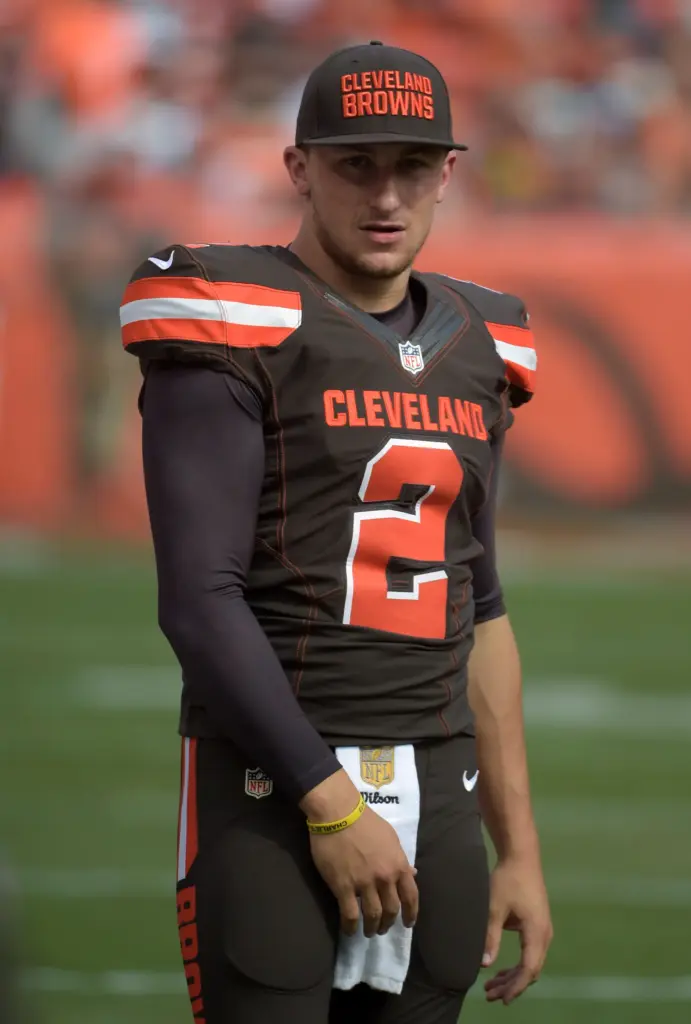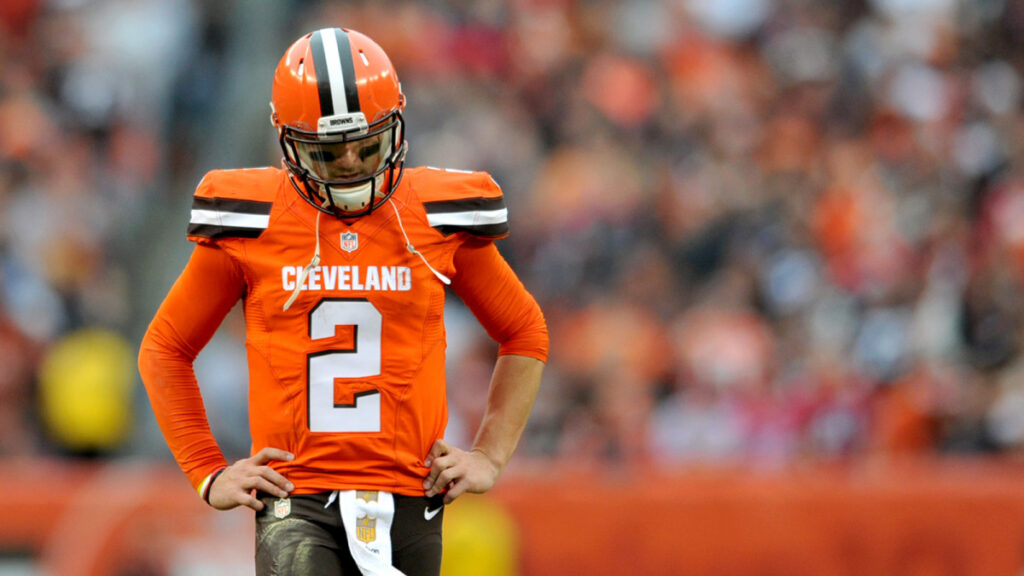Johnny Manziel, the electrifying Texas A&M quarterback known as “Johnny Football,” captivated college football with his 2012 Heisman Trophy win, but his NFL career fizzled amid off-field controversies. As of July 2025, Manziel’s net worth is estimated at $1 million, a stark contrast to the $100 million potential once projected for his professional career.
A recent Houston Chronicle article on July 7, 2025, highlights how the NCAA’s Name, Image, and Likeness (NIL) rules, introduced in 2021, could have transformed Manziel’s financial and professional path had they existed during his 2012–2013 college tenure. This article examines Manziel’s net worth, career earnings, potential NIL deals at Texas A&M, and how staying in college longer might have reshaped his NFL trajectory, offering a cautionary tale for today’s athletes.

🔍 Key Facts of Manziel’s Career and the NIL Era
Johnny Manziel, born December 6, 1992, in Tyler, Texas, rose to fame as a redshirt freshman at Texas A&M in 2012, becoming the first freshman to win the Heisman Trophy. His dual-threat prowess—3,706 passing yards, 26 touchdowns, and 1,410 rushing yards in 2012—set NCAA and SEC records, per Sports-Reference. However, off-field issues, including a 2013 NCAA investigation into autograph sales, marred his college legacy.
Manziel entered the 2014 NFL Draft after two seasons, forgoing two years of eligibility. Selected 22nd overall by the Cleveland Browns, his NFL stint lasted two seasons, derailed by substance abuse and domestic violence allegations, per ESPN. His net worth, estimated at $1 million in 2025 by Celebrity Net Worth, reflects earnings from a brief NFL career, endorsements, and post-football ventures like the Netflix documentary Untold: Johnny Football.
The Houston Chronicle article notes that NIL rules, allowing athletes to profit from their name, image, and likeness since 2021, could have netted Manziel millions in college. In a July 2025 interview with Greg McElroy, Manziel claimed he would have “taken a pay cut” entering the NFL, as NIL earnings in College Station could have exceeded his $7.7 million NFL salary.
With Texas A&M’s $450 million stadium renovation and massive booster support, Manziel’s marketability could have rivaled today’s top NIL earners like Arch Manning ($3.1 million annually, per On3). This financial incentive might have kept him in college, potentially altering his NFL trajectory by fostering discipline and development.

💸 Money Angle: Net Worth and Career Earnings
Johnny Manziel’s Net Worth in 2025
Johnny Manziel’s net worth in 2025 is estimated at $1 million, per Celebrity Net Worth, a significant drop from earlier estimates of $6 million in 2023, per Sportskeeda. This decline reflects his limited professional earnings, lavish spending, and off-field struggles. In the 2023 Netflix documentary Untold: Johnny Football, Manziel admitted to a $5 million “bender” during and after his NFL years, depleting much of his wealth. His current fortune stems from NFL earnings, endorsements, and recent ventures like Fan Controlled Football (FCF) and media appearances.
- NFL Earnings: Manziel signed a four-year, $8.25 million contract with the Cleveland Browns in 2014, including a $4.3 million signing bonus, per Spotrac. Over two seasons (2014–2015), he earned $7.7 million, with a base salary of $420,000 in 2014 and $794,936 in 2015, plus a $2.17 million final paycheck in 2016 when the Browns cut him. His total NFL earnings were $7,707,913.
- CFL and AAF Earnings: In 2018, Manziel signed with the Hamilton Tiger-Cats in the Canadian Football League (CFL) for approximately $500,000 annually but played only five games before a trade to the Montreal Alouettes. He earned $70,000 with the Memphis Express in the Alliance of American Football (AAF) in 2019, per Pro Football Network. The AAF folded mid-season, limiting his earnings.
- FCF Earnings: Manziel played for the FCF Zappers from 2021–2022, earning $400–$750 weekly, totaling $2,400–$4,500 per six-week season, per Briefly.co.za. This added roughly $5,000–$10,000 to his income.
- Endorsements: Manziel earned $10 million from endorsements during his NFL career, primarily from a multi-year Nike deal signed in 2014, per Celebrity Net Worth. Additional deals with Nissan, McDonald’s, Panini America, MusclePharm, and Snickers were terminated by 2016 due to controversies. In 2025, he earns modest sums from Cactus Hack, a golf apparel brand, and social media promotions, estimated at $50,000–$100,000 annually.
- Netflix Documentary: Manziel’s pay for Untold: Johnny Football is undisclosed, but similar documentaries pay athletes $50,000–$200,000, per industry estimates. This likely added $100,000–$150,000 to his net worth.
After taxes (40–45%) and agent fees (3–5%), Manziel’s net earnings from $18 million in pre-tax income (NFL, endorsements, other leagues) are approximately $10–$11 million. His $1 million net worth reflects significant spending, including the $5 million bender and a $400,000 lake house fire in 2015, per Celebrity Net Worth.
Potential NIL Deals at Texas A&M
Had NIL rules existed in 2012–2013, Manziel’s marketability as “Johnny Football” could have generated millions, rivaling today’s top college athletes. The Houston Chronicle cites Manziel’s claim that he could have earned more in college than his $7.7 million NFL salary. On3 estimates Texas quarterback Arch Manning’s 2025 NIL valuation at $3.1 million, despite limited playing time. Manziel, with his Heisman win, 5,116 yards of total offense in 2012, and massive social media following, could have surpassed this.
- Estimated NIL Valuation: Experts, including TexAgs’ Billy Liucci, suggest Manziel could have earned $5–$10 million annually in NIL deals, per On3. His 2012 upset over Alabama and record-breaking stats fueled “Manziel Mania,” doubling Texas A&M’s donations to $740 million, per The Guardian. This suggests a valuation closer to $10 million per year, comparable to Duke’s Darian Mensah ($8 million over two years, per New York Post).
- Potential Deals:
- National Brands: Nike, which signed Manziel in 2014, would likely have offered $2–$3 million annually, per industry standards for Heisman winners. Gatorade, Under Armour, and Beats by Dre could have added $1–$2 million each, totaling $5–$7 million yearly.
- Local Sponsorships: Texas A&M’s booster network, which funded a $450 million stadium renovation, could have secured deals with local car dealerships ($500,000–$1 million/year), restaurants ($200,000–$500,000/year), and Texas-based brands like Whataburger ($500,000–$1 million/year), per Sports Illustrated.
- Social Media: With an estimated 1–2 million Instagram followers in 2012–2013 (based on his post-NFL 1.5 million followers), Manziel could have earned $20,000–$50,000 per sponsored post, totaling $500,000–$1 million annually, per Influencer Marketing Hub.
- Autographs and Memorabilia: Manziel earned $33,000 illegally signing autographs in 2013, per Untold: Johnny Football. In the NIL era, legal autograph deals with companies like Fanatics could have netted $1–$2 million annually, given his jersey sales topped NCAA charts in 2012.
- Total Potential Earnings: Combining national ($5–$7 million), local ($1–$2.5 million), social media ($0.5–$1 million), and autograph deals ($1–$2 million), Manziel could have earned $7.5–$12.5 million annually, or $15–$25 million over two additional college years.

Financial Impact on Texas A&M
Manziel’s presence boosted Texas A&M’s profile, doubling donations to $740 million and funding a $450 million Kyle Field renovation, per The Guardian. Legal NIL earnings could have amplified this, with Manziel’s deals attracting more boosters and elevating the program’s recruiting power.
However, his autograph scandal in 2013 led to a half-game suspension, highlighting NCAA restrictions. In the NIL era, Texas A&M’s $27 million NIL budget in 2025, per On3, suggests Manziel could have commanded 20–30% of it, strengthening the Aggies’ SEC standing.
📈 Career Background and NFL Trajectory
Manziel’s college career at Texas A&M (2011–2013) was historic. In 2012, he threw for 3,706 yards, 26 touchdowns, and rushed for 1,410 yards, breaking Cam Newton’s SEC total offense record (5,116 yards). His 2013 season—4,114 passing yards, 37 touchdowns—cemented his stardom, though off-field antics, including partying with celebrities like Drake and LeBron James, drew scrutiny, per Netflix’s Untold. Entering the 2014 NFL Draft, Manziel was a polarizing prospect. Selected 22nd overall by the Browns, his NFL career faltered:
- 2014 Season: Manziel played five games, starting two, completing 18 of 35 passes for 175 yards, zero passing touchdowns, and two interceptions. His lone rushing touchdown came against Buffalo. A $12,000 NFL fine for an obscene gesture underscored his struggles, per Wikipedia.
- 2015 Season: Starting six games, he threw for 1,500 yards, seven touchdowns, and five interceptions, showing flashes of potential but lacking consistency. Off-field issues, including a domestic violence allegation by ex-girlfriend Colleen Crowley, led to his release in March 2016, per ESPN.
- Post-NFL: Manziel played in the CFL (2018, $500,000) and AAF (2019, $70,000) but was banned from the CFL for violating contract terms, including missing mental health treatments, per Pro Football Network. His FCF stint (2021–2022) earned minimal income.
Manziel’s bipolar disorder, diagnosed later, and substance abuse issues contributed to his downfall, per Untold. He admitted to neglecting film study and playbooks, per Reddit’s r/NFLNoobs, alienating teammates and coaches. His NFL earnings ($7.7 million) and endorsements ($10 million) totaled $18 million pre-tax, but his $5 million bender and legal troubles eroded his wealth.

How NIL Could Have Changed His NFL Trajectory
Had NIL been available in 2012–2013, Manziel believes he would have stayed at Texas A&M for two more years, per NBC Sports. This decision could have altered his NFL path in several ways:
- Extended Development: TexAgs’ Billy Liucci noted Manziel was not NFL-ready in 2013, lacking the discipline to play within structure, per On3. Two additional years under coach Kevin Sumlin and offensive coordinator Jake Spavital could have honed his skills, improving his pocket presence and decision-making. His 68.9% completion rate and 63 touchdowns in college suggest a higher ceiling with more seasoning.
- Improved Draft Stock: Staying until 2015 could have positioned Manziel as a top-10 pick, potentially doubling his rookie contract to $15–$20 million, per Spotrac’s 2015 draft data. A stronger college resume, including a potential 2014 College Football Playoff run, might have landed him with a more stable franchise, avoiding Cleveland’s dysfunctional environment.
- Financial Stability: Earning $15–$25 million in NIL deals could have reduced financial pressure to enter the NFL early, per Manziel’s comments to Greg McElroy. This stability might have curbed his party-heavy lifestyle, allowing focus on mental health and preparation. Manziel noted that “a couple million bucks in College Station goes a long way,” suggesting a more grounded approach.
- Cultural Impact: Staying in college could have mitigated off-field controversies. The structure of college life, with academic and team obligations, might have limited his access to the celebrity circles that fueled his excesses, per Untold. Avoiding the 2016 domestic violence allegations could have preserved his marketability and endorsements.
However, risks remain. Manziel’s bipolar disorder and addiction issues, undiagnosed until later, could have persisted, per The Guardian. X posts suggest NIL money might have “ruined him faster” by enabling his lifestyle, with one user noting, “Manziel flew to Vegas the day before a game” (@nfldigest01). His autograph scandal, earning $33,000 illegally, indicates a propensity for rule-breaking that NIL might have amplified.
🌟 Brand, Influence & Cultural Impact
Manziel’s “Johnny Football” persona made him a cultural phenomenon, with his No. 2 jersey topping NCAA sales in 2012, per Sports Illustrated. His 2012 Alabama upset and highlight-reel plays garnered millions of social media views, per Netflix.
X posts in 2025 reflect his lasting impact, with @tariq_ahmad noting, “The Johnny Football craze was next level,” and @ClubShayShay citing his $10 million NIL estimate. However, his controversies—partying, a $12,000 NFL fine, and domestic violence allegations—tarnished his brand, costing him Nike and other deals, per Celebrity Net Worth.
In the NIL era, Manziel’s influence could have been seismic. His 1–2 million estimated followers in 2012–2013 would have rivaled Arch Manning’s, securing deals with Nike, Gatorade, and local brands. Texas A&M’s $740 million donation surge during his tenure shows his economic impact, per The Guardian.
However, his autograph scandal and NCAA suspension sparked debates about athlete compensation, contributing to the 2021 NIL rule change, per Untold. X users like @ProFootballTalk highlight his regret: “NIL would’ve kept me in college,” reflecting a missed opportunity to build wealth and stability.

📌 The Distinct Athlete Angle
Johnny Manziel’s $1 million net worth in 2025 underscores a career of untapped potential, with $18 million in pre-tax earnings eroded by a $5 million bender and off-field issues. In the NIL era, he could have earned $15–$25 million at Texas A&M, rivaling today’s top earners like Arch Manning.
Staying in college might have improved his NFL readiness, draft stock, and financial stability, potentially avoiding the controversies that derailed his career. His story highlights the NIL era’s transformative power, offering athletes like Manziel a chance to build wealth and discipline before the pros, but also warns of the risks of unchecked fame and personal struggles.
Conclusion
Johnny Manziel’s $1 million net worth in 2025 reflects a meteoric college career overshadowed by NFL struggles, with $7.7 million in NFL earnings and $10 million in endorsements diminished by lavish spending. Had NIL rules existed in 2012–2013, Manziel could have earned $15–$25 million at Texas A&M, per his estimates, through deals with Nike, Gatorade, and local sponsors. Staying in college might have honed his skills, boosted his draft stock, and curbed off-field issues, altering his NFL trajectory. As the NIL era empowers today’s athletes, Manziel’s story, amplified by Untold: Johnny Football and the Houston Chronicle, serves as both a cautionary tale and a testament to the financial revolution in college sports.
Related Reads on Distinct Athlete
- BREAKING DOWN 2025’S ELITE QBS AND THEIR FINANCIAL VALUE
- TIM TEBOW AND WIFE WELCOME BABY GIRL, DAPHNE REIGN
- BRIAN KELLY’S ON THE HOT SEAT: CAN LSU AFFORD TO FIRE HIM?
Join the Conversation
Would NIL have saved Johnny Manziel’s NFL career, or amplified his struggles? Follow us on Instagram, Facebook, and X @DistinctAthlete.

